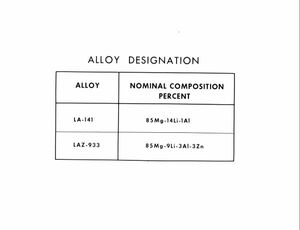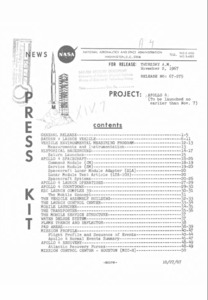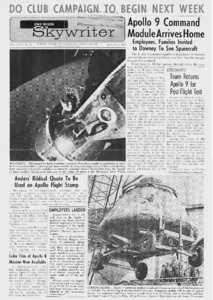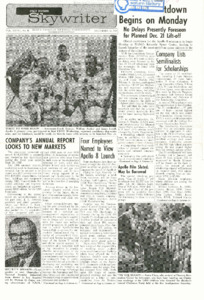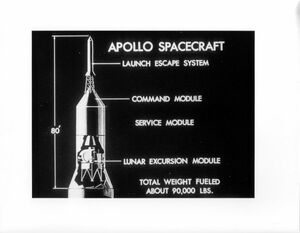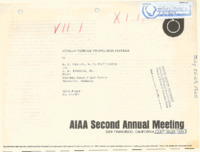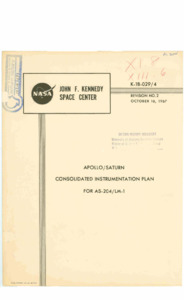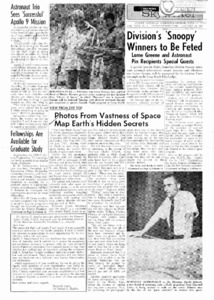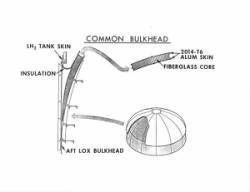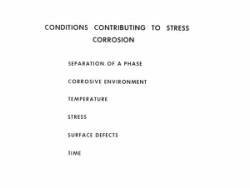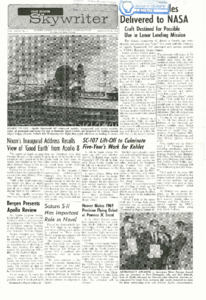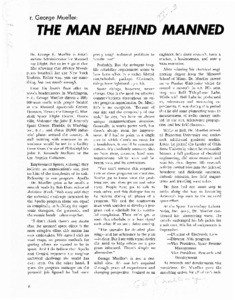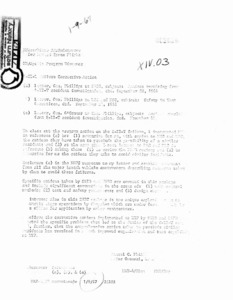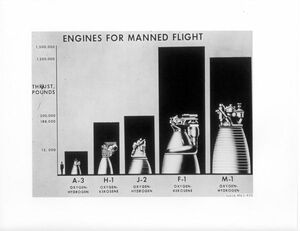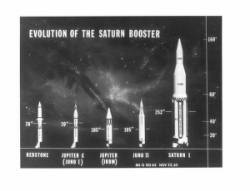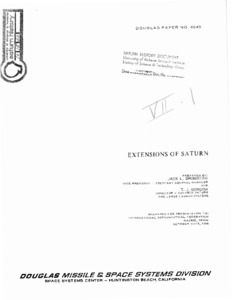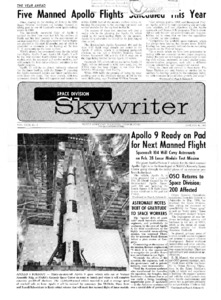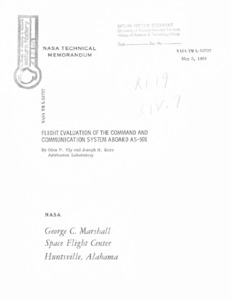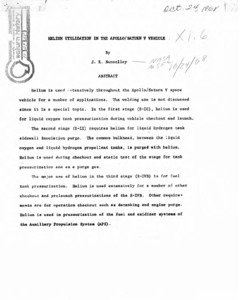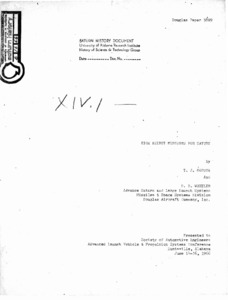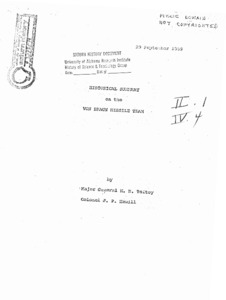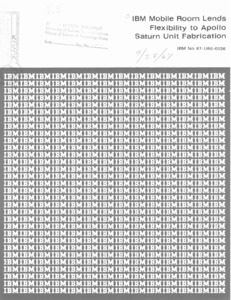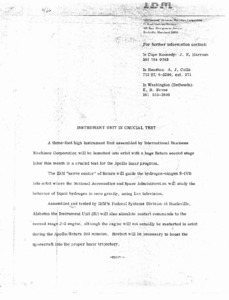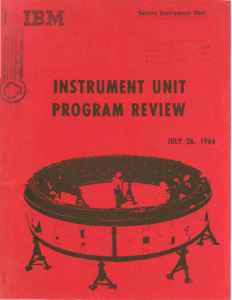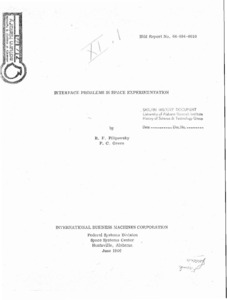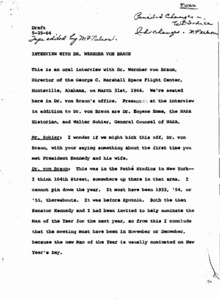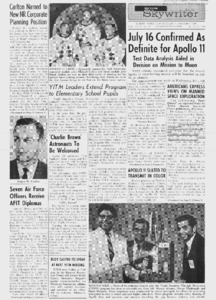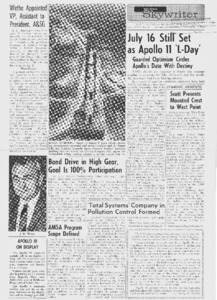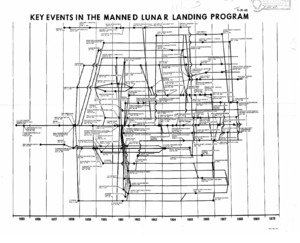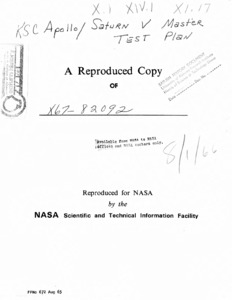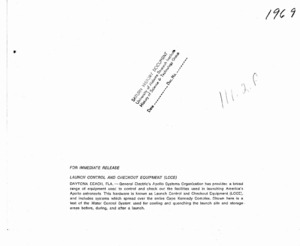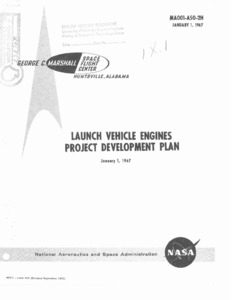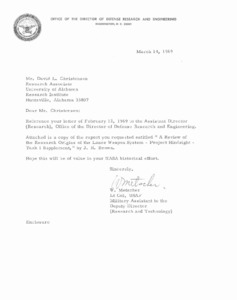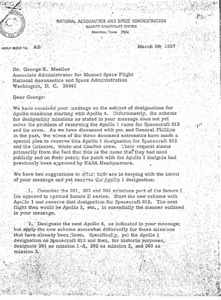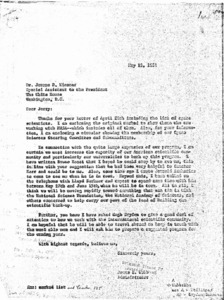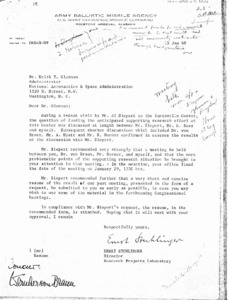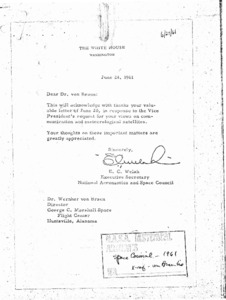
Browse Items (156 total)
Sort by:
-
"Alloy designation" Table.
8 x 10 inch black and white photograph that displays a table of two elements and their molecular makeup. Table includes the alloy of LA-141 and LAZ-933. -
"Apollo 4 press kit."
The flrst flight test of the Apollo/Saturn V space vehicle is scheduled for launch from the Natlonal Aeronautics and Space Administration's John F, Kennedy Space Center, Fla., no earlier than Nov. 7. The mission is designated Apollo 4. -
"Apollo 8 Mission (AS-503) : memorandum to A/Acting Administrator from MA/Apollo Program Director."
Memorandum discussing the first manned Saturn V flight, its purpose and when/where the launch will take place. -
"Apollo 9 command module arrives home."
News article detialing the recovery of the Apollo 9 command module and the events planned around its display. -
"Apollo 9 flight ends; Astronauts return."
News article detailing the recovery of the Apollo 9 crew after their mission -
"Apollo countdown begins on Monday."
News article detailing the interest around the liftoff of the Apollo 8 spacecraft. -
"Apollo spacecraft Diagram."
8 x 10 inch black and white diagram of an Apollo spacecraft, each section labled for easy identification. -
"Apollo Vehicle Propulsion Systems."
This paper discusses the propulsion requirements for various stages of the Apollo vehicles and the development of these engines. -
"Apollo/Saturn consolidated instrumentation plan for AS-204/LM-1."
This report represents the consolidated instrumentation plan for employing optical and electronic data acquisition systems to monitor the performance and trajectory of the Apollo/Saturn 1B vehicle, AS-2 04/LM-1, during powered flight. Telemetry and electronic tracking equipment on board the vehicle, and data acquisition systems monitoring the flight are discussed. Flight safety instrumentation and vehicle data transmission are described, and geophysical information is provided. This plan reflects the general instrumentation coverage requirements set forth in the NASA Program Support Requirements Document (PSRD) for Apollo/Saturn 16, and the commitments of Eastern Test Range (ETR) Operations Directive (OD) No. 4206,dated 15 August 1967. This plan is not intended to conflict with or to supersede either document. The information presented in this document reflects planning concepts developed prior to October 1, 1967. -
"Astronaut trio sees 'successful' Apollo 9 mission."
News article detailing the hope from the Apollo 9 crew that their mission will be a success. -
"Common bulkhead drawing."
8 x 10 inch black and white photograph; This is a cutaway drawing of the bulkhead with information about the LH2 tank skin, insulation, Aft LOX bulkhead, 2014-T6 alum skin and fiberglass core. Part of an envelope with photos accompanying C. E. Cataldo paper "Materials in Space Exploration." -
"Conditions contributing to stress corrosion [list] photograph."
8 x 10 inch black and white photograph. A photograph of a list of things contributing to stress corrosion. Referenced by "Materials in Space Exploration." Is part of envelope containing photos accompanying C. E. Cataldo paper "Materials in Space Exploration." -
"Craft destined for use in lunar landing mission."
News article detailing how the Apollo spacecraft 107 command modules are planned to be used in future space-missions. -
"Dr. George Mueller: The Man Behind Manned."
G. E. Challenge. Article written about George Mueller, NASA Associate Administrator for Manned Space Flight. -
"Engineering Capabilities Presentation."
This Engineering Capabilities Presentation lists the competence and capability that has been demonstrated by the Space Support Division of Sperry Rand Corporation while fulfilling contractual commitments in the aerospace industry. This is a preliminary presentation; the preparation of a complete capabilities history of the division is currently in the developmental stage. The Capabilities Experience Summary is comprised of ten categories. e.g. Category 1 - Aeronautics, etc. The capabilities reported herein were performed by the Space Support Division under Contract NAS8-20055 to the National Aeronautics and Space Administration, George C. Marshall Flight Center, Astrionics Laboratory, Huntsville, Alabama. -
"Engines for Manned Flight."
8 x 10 inch black and white photograph.; Images included are: A-3 oxygen-hydrogen, H-1 oxygen-kerosene, J-2 oxygen-hydrogen, F-1 oxygen-Kerosene, M-1 oxygen-hydrogen. The thrust pounds is also listed.Shows them in reference to a human as a scale. -
"Evolution of the Saturn Booster."
8 x 10 inch Black & White photograph. MS-G 103-63 Nov. 22, 63 is on the photograph. Displays the evolution of space-rocket designs side-by-side. -
"Extensions of Saturn."
This paper discusses the possible applications of Saturn vehicles to future space exploration. Potential missions utilizing Apollo derived hardware are examined. Research, development, and operations in earth orbit as well as lunar exploration, unmanned and manned interplanetary exploration are reviewed. These hypothetical missions are discussed in the context of the present and potential capability of three configurations of the Saturn vehicle; an uprated Saturn I, a three-stage Saturn V and a four-stage Saturn V. NOTE: Work presented herein was conducted by the Douglas Missiles and Space Systems Division under company-sponsored research and development funds. Therefore, the concepts and objectives described within this paper reflect the opinions of the authors and do not necessarily constitute endorsement by NASA, the Air Force, or any other U.S. Government organization. The nominal performance numbers presented are typical of the current configurations and possible future vehicle configurations. -
"First Annual Logistics Management Symposium: September 13 and 14, 1966."
The proceedings of the First Annual Logistics Management Symposium are forwarded with the hope that the information will be of assistance to attendees and their staffs in the planning and management of logistics support programs. I recognize that there is still much study required before all management techniques and procedures for support programs are known and understood, but I believe that support problems are made easier by exchange of knowledge. The Symposium was based on this belief and we plan to continue the search for ways to achieve better program support at a lower cost. Edmund F. O'Connor, Director, Industrial Operations. -
"Five manned Apollo flights scheduled this year."
News article detailing the planning of five more projects after the successful mission of Apollo 8. -
"Flight Evaluation of the Command and Communication System Aboard AS-501."
The first test of the command and communications system, a unified frequency S-band system, aboard AS-501 was successful. Compatibility of this system with the MSFN/USB sites was established. The onboard transponder and antenna system including antenna switching performed as predicted. The command performance was excellent with 5747 valid commands received onboard out of 5748 commands transmitted. Data reduction problems prevented a complete analysis of the tracking data. Telemetry system performance was satisfactory with a measured bit-error-rate of 4 x10-5 while over the Ascension Island station. This flight provided valuable data which can be used to define vehicle to-ground-station interfaces, to establish attitude constraints during translunar injection, and to improve operational procedures. One more test as successful as the AS-501 test would qualify the system as operational.; May 3,1968. -
"Helium Utilization in the Apollo/Saturn V Vehicle."
Helium is used extensively throughout the Apollo/Saturn V space vehicle for a number of applications. The welding use is not discussed since it is a special topic. In the first stage (S-IC), helium is used for liquid oxygen tank pressurization during vehicle checkout and launch. -
"High Energy Missions for Saturn."
Presented to Society of Automotive Engineers, Advanced Launch Vehicle & Propulsion Systems. When the Apollo lunar landing project is complete, the Saturn and Apollo hardware will only have begun to realize their ultimate potential for space exploration. The immense reserve of Apollo technology, facilities, and booster capability can then be directed to the achievement of national goals which lie far beyond the initial lunar landing. In achieving the Apollo lunar objectives, large investments will have been made in launch facilities, tracking systems, propulsion techniques, reentry systems, lunar landing systems and rendezvous technologies. Although developnent in these specialized areas has been tailored to the needs of Apollo, numerous studies by NASA and industry have demonstrated the feasibility of using the spacecraft, launch vehicles, and operating techniques for missions far more complex than lunar landings. Amortization of this hardware will prove cost-effective for missions of more sophisticated applications. -
"IBM Mobile Room Lends Flexibility to Apollo Saturn Unit Fabrication."
This article was published in the April 1967 issue of Contamination Control, Volume VI, Number 4. States: "The extreme sensitivity of critical parts in the Apollo /Saturn Instrument Unit (IU) has demanded unique clean room techniques by International Business Machines Corporation." -
"Instrument Unit in Crucial Test."
A three-foot high Instrument tional Business Machines Corporation will be launched into orbit with a huge Saturn second stage
later this month in a crucial test for the Apollo lunar program. -
"Instrument Unit Program Review : Saturn Instrument Unit."
Handwritten names and phone numbers on the first page. Apollo / Saturn Team. -
"Interface Problems in Space Experimentation."
Space experimentation is expanding rapidly. Unmanned satellites are being equipped with precision instruments of greater power, and manned space stations accommodating large crews are in the drawing-board stage. The interface problems between these sophisticated instruments and between man, the spacecraft, and the supporting groundstations are multidimensional. This paper analyzes the scientific/technical areas of space experimentation, and continues with a review of the subsystems and support systems required to supply and operate the large variety of instruments. Areas of major integration efforts are singled out and the requirements for further developments and improvements are listed. A bibliography of 95 references is enclosed to assist in the identification of more detailed reports on all vital aspects of space experimentation.; Archive copy is a photocopy.; Supplement to IEEE Transactions on Aerospace and Electronic Systems, Vol. AES-2, No. 4, July, 1966. Pages 237 to 255. -
"Interview with Dr. Wernher von Braun."
Transcription of an interview with Wernher von Braun and Mr. Sohier. -
"July 16th confirmed as definite for Apollo 11."
News article covering NASA's announcement of Apollo 11's launch-date: July 16th. -
"July 16th still set as Apollo 11's 'L-Day.'"
News article confirming NASA's announcement of Apollo 11's launch-day. Focuses on the optimism surrounding the launch as well. -
"KSC Apollo/Saturn V Master Test Plan."
The John F. Kennedy Space Center (KSC) Apollo/Saturn V Development/Operations Plan, K-PM-0, establislies the requirement for an Apollo/Saturn V Master Test Plan (MBP). This document, prepared by the Saturn Systems Office. -
"Launch Control and Checkout Equipment (LCCE) [photograph]."
Description of an 8 x 10 inch black and white photograph. -
"Launch Vehicle Engines Project Development Plan."
This revised edition of the Launch Vehicle Engines Project Development Plan supersedes the issue dated July 1, 1965. Significant changes which have been made are:- Removal of classified data to permit publication as an unclassified document; - Removal of material applicable to the RL-10 Engine Project which was transferred to the Lewis Research Center effective May 1, 1966; - Elimination of detailed schedules which quickly become obsolete; - Punched for maintenance in loose-leaf 3-ring binders and for ease in updating material through issuance of replacement sheets. Binders are not furnished. The information in this document is current to January 1, 1967.; The Launch Vehicle Engines Project Development Plan is established in accordance with requirements of NASA General Management Instruction 4-1-1, Planning and Implementation of NASA Projects, and OMSF Instruction MP 9320.044, Preparation and Revision of Program/Project Development Plans (PDP's). The Plan, herein referred to as the PDP, has been developed within the scope of current Apollo Projects Approval Documents (PADS) and will be maintained by the Engine Program Manager to identify program requirements, responsibilities, tasks, and resources, and time phasing of major actions required to accomplish the Engine Program. -
"Letter from Mr. David L. Christensen."
Letter stating that "A review of the research origins of the Lance weapon system - Project Hindsight -Task 1 supplement" is inside as requested. -
"Letter to Dr. George E. Mueller."
This letter regarding designations for Apollo missions notes that "Unfortunately, the scheme for designating missions as stated in your message does not yet solve the problem of reserving the Apollo 1 name for Spacecraft 012 and its crew. As we have discussed with you and General Phillips in the past, the wives of the three deceased astronauts have made a special plea to reserve this Apollo 1 designation for Spacecraft 012 and the Grissom, White and Chaffee crew."; Archive copy is a photocopy.; In replay refer to: AB. -
"Letter to Dr. Jerome B. Wiesner."
Letter to Jerome B. Wiesner from Jones B. Webb regarding requested documents as well as how they, as scientists, interact with the scientific community. -
"Letter to Dr. Keith T. Glennan."
Letter to Kieth T. Glennan from Ernst Stuhlinger regarding a potential meeting between Glennan, Wernher von Braun Horner and Ernst himself. Attached is a required resume. -
"Letter to Dr. Wernher von Braun."
Letter to Wernher von Braun from E.C. Welsch thanking Braun for his letter on June 20th regarding his thoughts on communication and meteorological satilites.
